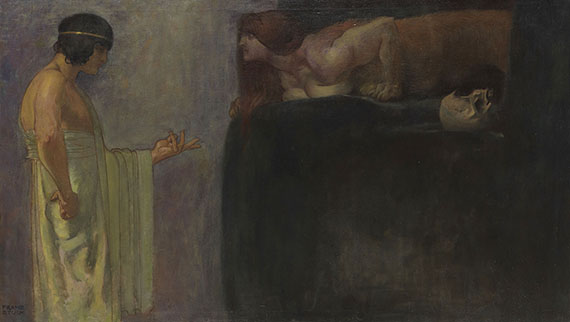Dictionary


Art Colony Ahrenshoop
The small village of Ahrenshoop, on the peninsula Fischland-Darß in an idyllic and remote location between the Saaler Bodden and the Baltic Sea, had attracted numerous artists even before the days of the artists' colony. The Liebermann student Eva Stort (1855-1936), Carl Malchin (1838-1923) and Karl Rettich (1841-1904) worked in Ahrenshoop and were inspired by the landscape's particular atmosphere.
However, Paul Müller-Kaempff (1861-1941) is regarded as the actual founding father of the Ahrenshoop artists' colony: After he and his friend Oskar Frenzel had spent several summers in the small village, Müller Kaempff settled in Ahrenshoop in 1892 and opened a painting school in 1894, the "Haus St. Lukas". Other artists would soon come to Ahrenshoop, united in their common fancy for motifs of the landscape surrounding the village, however, not with a common style. Among the members of the Ahrenshoop colony count Anna Gerresheim (1852-1921) and Elisabeth von Eicken (1862-1940), who had been educated in Paris, her depictions of autumnal forests had attained certain fame. Fritz Grebe (1850-1920) and Hugo Richter-Lefensdorf (1854-1904) came to Ahrenshoop in 1896, followed by Friedrich Wachenhusen (1859-1925), who often painted atmospherically dense winter landscapes, a year later.
Other places in the Ahrenshoop environs also attracted numerous artists, among them Carl Friedrich Koch, Hugo Jaeckel and Heinrich Schlotermann.
Some 16 artists worked and taught in the Ahrenshoop region at the turn of the century, especially as private classes were the then only way for women to be trained in arts. The attraction of Ahrenshoop remained unbowed, for instance the Munich artist Theobald Schorn (1866-1913) and the portrait painter Franz Triebsch (1870-1956) settled there. In 1909 Paul Müller-Kaempff and Theobald Schorn initiated the "Kunstkaten" (Art Cottage), the exhibition space would additionally contribute to the place's attractiveness, which is why numerous artists visited the peninsula, among them Cesar Klein, Erich Heckel, Alexej von Jawlensky and Marianne von Werefkin.
World War I marked the end of the artists' colony Ahrenshoop; however, the artists began to visit the village again after the end of the war, mostly during the summer months. Among this second generation, which did not work together in a colony any longer, were artists such as Hedwig Woermann (1879-1960), Theodor Schultze-Jasmer (1888-1975), Alfred Partikel (1888-1945) and Gerhard Marcks (1889-1981).
The small village of Ahrenshoop, on the peninsula Fischland-Darß in an idyllic and remote location between the Saaler Bodden and the Baltic Sea, had attracted numerous artists even before the days of the artists' colony. The Liebermann student Eva Stort (1855-1936), Carl Malchin (1838-1923) and Karl Rettich (1841-1904) worked in Ahrenshoop and were inspired by the landscape's particular atmosphere.
However, Paul Müller-Kaempff (1861-1941) is regarded as the actual founding father of the Ahrenshoop artists' colony: After he and his friend Oskar Frenzel had spent several summers in the small village, Müller Kaempff settled in Ahrenshoop in 1892 and opened a painting school in 1894, the "Haus St. Lukas". Other artists would soon come to Ahrenshoop, united in their common fancy for motifs of the landscape surrounding the village, however, not with a common style. Among the members of the Ahrenshoop colony count Anna Gerresheim (1852-1921) and Elisabeth von Eicken (1862-1940), who had been educated in Paris, her depictions of autumnal forests had attained certain fame. Fritz Grebe (1850-1920) and Hugo Richter-Lefensdorf (1854-1904) came to Ahrenshoop in 1896, followed by Friedrich Wachenhusen (1859-1925), who often painted atmospherically dense winter landscapes, a year later.
Other places in the Ahrenshoop environs also attracted numerous artists, among them Carl Friedrich Koch, Hugo Jaeckel and Heinrich Schlotermann.
Some 16 artists worked and taught in the Ahrenshoop region at the turn of the century, especially as private classes were the then only way for women to be trained in arts. The attraction of Ahrenshoop remained unbowed, for instance the Munich artist Theobald Schorn (1866-1913) and the portrait painter Franz Triebsch (1870-1956) settled there. In 1909 Paul Müller-Kaempff and Theobald Schorn initiated the "Kunstkaten" (Art Cottage), the exhibition space would additionally contribute to the place's attractiveness, which is why numerous artists visited the peninsula, among them Cesar Klein, Erich Heckel, Alexej von Jawlensky and Marianne von Werefkin.
World War I marked the end of the artists' colony Ahrenshoop; however, the artists began to visit the village again after the end of the war, mostly during the summer months. Among this second generation, which did not work together in a colony any longer, were artists such as Hedwig Woermann (1879-1960), Theodor Schultze-Jasmer (1888-1975), Alfred Partikel (1888-1945) and Gerhard Marcks (1889-1981).
Offers




